Falcon Northwest FragBox SLI: Dare to Dream
by Jarred Walton on May 3, 2006 9:00 AM EST- Posted in
- Systems
Construction and Assembly
Still too expensive for you? There's an alternative you might consider if you really like the FragBox case. Falcon offers the FragBox as a DIY chassis for $299, or you can get it with a 600W modular PSU (with a "short cable" kit) for $518. Either way, you get the case as well as cold cathode lighting setup (including an inverter for the lights). Note that if you go the DIY route, you can only get the "FragBox" faceplate and not the "Falcon Northwest" option, which makes sense. Exotix paint jobs are also not offered for the DIY setup.
The case and PSU are made by SilverStone, a company known for building high quality cases. Add in the EVGA SLI motherboard and you're looking at about $700 total for a "barebones" configuration. If you really like the looks but you don't want to pay the price premium - not that $300 for a chassis is cheap, of course, but it's not too bad all things considered - you can buy the DIY kit and add your own modular ATX PSU and motherboard purchased at any of the typical online resellers. That will cut around $125 from the price of the barebones, though whether or not you're getting equivalent quality is up for debate. If you compare that price with the Shuttle SN26P and the Monarch Hornet Pro, the FragBox SLI DIY system is pretty competitive. Finally, you can also go with the SilverStone SG01 for $150 - that's the basis of the FragBox design. At that point, you lose the lights, acrylic face plate, side windows, and carrying handle. It's still a reasonable uATX case, but it's certainly not going to turn heads like the FragBox.
How does the system work as a barebones offering? First, it has to be said that the case isn't super easy to work with, but any competent enthusiast will be able to handle it. Falcon makes no claims about offering a simple-to-assemble barebones - quite the contrary. From their website: "Small Form Factors are by nature not as easy to work in as towers. There's not much room for knuckles, and sometimes a part will need to be removed to access another part. Patience is important." That pretty much sums up the situation. Once the system is properly assembled, you really don't have to worry anymore about how difficult the assembly process might have been. It's slightly more difficult than working with a spacious tower or mid-tower ATX case, but it shouldn't take more than an hour or two to put everything together. If you're the type of person that frequently upgrades components, the case is certainly not geared towards making your life easier; the more common infrequent upgraders will be far more concerned with appearance and performance than ease of assembly.
For those thinking of going the DIY route, we did take the time to dismantle the case, swap some components, and take some pictures. Here's a brief commentary on the process, as well as plenty of images. Larger 1280x960 images are available for the interested, but be warned that they weigh in at 150-200 KB each. We did not completely dismantle the system, as you will see in the images, but we did get down to the point where the only installed components remaining were the motherboard and a few other minor peripherals. You can also see where the wiring was placed by Falcon, which you may find useful if you're trying to assemble a system yourself.
Starting with the power supply, this is a full-size ATX unit. As you can see, it's also a modular power supply, although most of the cables are used for the FragBox SLI configuration we were sent. We mentioned before that this is a 600W power supply, and judging by the way this is a true 600W unit, and not one that simply makes that claim. The PSU has a large 120 mm fan, and the rear of the PSU has hexagonal perforations that allow for good airflow. In use, the power supply is relatively quiet, although as we'll see later this system as a whole certainly isn't silent.
A hard drive tray sits at the front of the case and can be removed for easier installation of the drives. More importantly for the high-end users, the hard drive tray is actively cooled by an 80mm fan, helping to reduce concern for data loss when running dual HDD configurations. This is particularly important if you plan on running RAID 0 - and we would still advise you to make frequent backups in that case. Once everything is installed, the various wires and cables tend to restrict airflow around the hard drives, but the active cooling should compensate for that.
Here you can see the shots of the system in a mostly disassembled state. You can already see that the number of wires coming off the power supply requires a lot of effort to fit into a case this small. Falcon lists the power supply as coming with a "short cable kit", but even then there's a lot of wires to deal with.
With just the motherboard installed, access to the CPU socket is relatively unrestricted. A support beam does run across the top of the case, but it doesn't get in the way. Considering that this is supposed to be something of a "small form factor" computer, you might be surprised at just how large your heatsink can be. Falcon ships prebuilt systems with Zalman CNPS7000 copper cooler. It's a relatively tight fit once everything is installed, as you can see from the images, but the Zalman cooler should keep temperatures lower as well as help to regulate noise levels. One issue that you might have with the Zalman heatsink comes from Falcon's top-end 1GB memory modules. They use Corsair TwinX 2048MB 3500LL Pro modules - complete with flashing lights - and due to their taller than average height and the large Zalman HSF, you can't install more than two DIMMs. FNW does give you the option of using some slightly cheaper and slightly lower performing Corsair TwinX 2048MB PC3200 modules, however. That As the move to Windows Vista and potentially a 64-bit OS and applications will make 4GB of RAM a conceivable upgrade during the life of the system, we would recommend avoiding the 3500LL Pro memory. Ideally, Falcon Northwest will offer another high-performance RAM option in the future -- or you could always just buy your own RAM when it comes time to upgrade.
Still too expensive for you? There's an alternative you might consider if you really like the FragBox case. Falcon offers the FragBox as a DIY chassis for $299, or you can get it with a 600W modular PSU (with a "short cable" kit) for $518. Either way, you get the case as well as cold cathode lighting setup (including an inverter for the lights). Note that if you go the DIY route, you can only get the "FragBox" faceplate and not the "Falcon Northwest" option, which makes sense. Exotix paint jobs are also not offered for the DIY setup.
The case and PSU are made by SilverStone, a company known for building high quality cases. Add in the EVGA SLI motherboard and you're looking at about $700 total for a "barebones" configuration. If you really like the looks but you don't want to pay the price premium - not that $300 for a chassis is cheap, of course, but it's not too bad all things considered - you can buy the DIY kit and add your own modular ATX PSU and motherboard purchased at any of the typical online resellers. That will cut around $125 from the price of the barebones, though whether or not you're getting equivalent quality is up for debate. If you compare that price with the Shuttle SN26P and the Monarch Hornet Pro, the FragBox SLI DIY system is pretty competitive. Finally, you can also go with the SilverStone SG01 for $150 - that's the basis of the FragBox design. At that point, you lose the lights, acrylic face plate, side windows, and carrying handle. It's still a reasonable uATX case, but it's certainly not going to turn heads like the FragBox.
How does the system work as a barebones offering? First, it has to be said that the case isn't super easy to work with, but any competent enthusiast will be able to handle it. Falcon makes no claims about offering a simple-to-assemble barebones - quite the contrary. From their website: "Small Form Factors are by nature not as easy to work in as towers. There's not much room for knuckles, and sometimes a part will need to be removed to access another part. Patience is important." That pretty much sums up the situation. Once the system is properly assembled, you really don't have to worry anymore about how difficult the assembly process might have been. It's slightly more difficult than working with a spacious tower or mid-tower ATX case, but it shouldn't take more than an hour or two to put everything together. If you're the type of person that frequently upgrades components, the case is certainly not geared towards making your life easier; the more common infrequent upgraders will be far more concerned with appearance and performance than ease of assembly.
For those thinking of going the DIY route, we did take the time to dismantle the case, swap some components, and take some pictures. Here's a brief commentary on the process, as well as plenty of images. Larger 1280x960 images are available for the interested, but be warned that they weigh in at 150-200 KB each. We did not completely dismantle the system, as you will see in the images, but we did get down to the point where the only installed components remaining were the motherboard and a few other minor peripherals. You can also see where the wiring was placed by Falcon, which you may find useful if you're trying to assemble a system yourself.
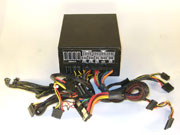 |
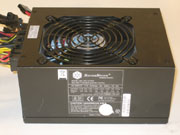 |
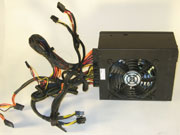 |
| Click to enlarge | ||
Starting with the power supply, this is a full-size ATX unit. As you can see, it's also a modular power supply, although most of the cables are used for the FragBox SLI configuration we were sent. We mentioned before that this is a 600W power supply, and judging by the way this is a true 600W unit, and not one that simply makes that claim. The PSU has a large 120 mm fan, and the rear of the PSU has hexagonal perforations that allow for good airflow. In use, the power supply is relatively quiet, although as we'll see later this system as a whole certainly isn't silent.
 |
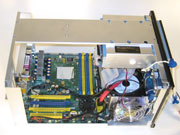 |
| Click to enlarge | |
 |
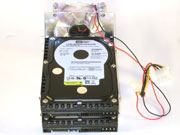 |
| Click to enlarge | |
A hard drive tray sits at the front of the case and can be removed for easier installation of the drives. More importantly for the high-end users, the hard drive tray is actively cooled by an 80mm fan, helping to reduce concern for data loss when running dual HDD configurations. This is particularly important if you plan on running RAID 0 - and we would still advise you to make frequent backups in that case. Once everything is installed, the various wires and cables tend to restrict airflow around the hard drives, but the active cooling should compensate for that.
 |
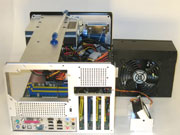 |
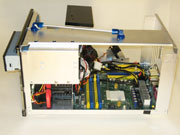 |
| Click to enlarge | ||
Here you can see the shots of the system in a mostly disassembled state. You can already see that the number of wires coming off the power supply requires a lot of effort to fit into a case this small. Falcon lists the power supply as coming with a "short cable kit", but even then there's a lot of wires to deal with.
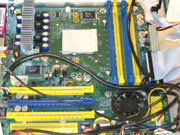 |
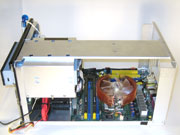 |
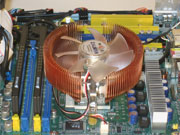 |
| Click to enlarge | ||
With just the motherboard installed, access to the CPU socket is relatively unrestricted. A support beam does run across the top of the case, but it doesn't get in the way. Considering that this is supposed to be something of a "small form factor" computer, you might be surprised at just how large your heatsink can be. Falcon ships prebuilt systems with Zalman CNPS7000 copper cooler. It's a relatively tight fit once everything is installed, as you can see from the images, but the Zalman cooler should keep temperatures lower as well as help to regulate noise levels. One issue that you might have with the Zalman heatsink comes from Falcon's top-end 1GB memory modules. They use Corsair TwinX 2048MB 3500LL Pro modules - complete with flashing lights - and due to their taller than average height and the large Zalman HSF, you can't install more than two DIMMs. FNW does give you the option of using some slightly cheaper and slightly lower performing Corsair TwinX 2048MB PC3200 modules, however. That As the move to Windows Vista and potentially a 64-bit OS and applications will make 4GB of RAM a conceivable upgrade during the life of the system, we would recommend avoiding the 3500LL Pro memory. Ideally, Falcon Northwest will offer another high-performance RAM option in the future -- or you could always just buy your own RAM when it comes time to upgrade.










32 Comments
View All Comments
JarredWalton - Wednesday, May 3, 2006 - link
Generally speaking, BIOS and driver updates are things that should only be used when necessary. It's the old "if it's not broke, don't fix it" situation. Does FNW provide a one-source solution for all your driver and software updates? No. If you ever send a system in for service, though, they will clean up everything and install the latest drivers and patches. Windows has gotten better with every release about detecting possible updates for drivers and software, and Vista should continue that trend.The issue is that Windows supports a far greater variety of hardware than OSX, and not all the manufacturers out there participate in every level of support/integration. I could create and release a software application for Mac, Windows, Linux, or any other OS and you wouldn't get automatic updates/patches unless I decide to include that feature. Apple can do automatic updates for the OS, drivers, and BIOS simply because they exercise tight control over those areas of the computer. That's why you also see graphics cards that cost an extra $100 for equivalent performance on Mac vs. Windows - the companies have to spend more money to meet the Apple requirements, and they pass that along to consumers.
Is there a market for a "one stop solution" for updates on Windows? Certainly. In order to fill that role, though, you have to basically do everything Microsoft does with WHQL, and then some. If you only want to support a subset of hardware, that would be easier, but that's basically what Microsoft already does.
In the end, I'm generally a believer in the market. The reason that this service doesn't exist in the form you specify is most likely that the cost/benefit can't be justified by anyone who has looked at it. Microsoft can justify tackling the problem, simply because it's their OS that people are using, and whether or not it's fair they get blamed for issues. I'm quite happy with the way Windows Update works, and about the only drivers that I find myself needing to manually download and install are for the graphics card and soundcard. I have to do BIOS updates as well, but I really wouldn't want anything to automatically apply such updates to my systems.
Pirks - Wednesday, May 3, 2006 - link
One thing that puzzles me in this cost/benefit equation is why the "elite" OEMs spend time on installing latest fastest hardware instead of spending time on integrating everything and providing butter-smooth Mac-like experience?Why is it that producing latest coolest fastest gaming rig is justified from the business perspective (Vodoo, Alienware, FNW, etc) and producing the smoothest no-problem, always-on, fire-and-forget all-purpose rig is NOT justified from business perspective?
Are the PC buyers more smart and tech savvy in general than Mac buyers? Of course not. Don't they want to forget about anything related to maintenance of their PC? Don't they won't their PCs to "just work"?
You're telling me that this desire to have "smooth" zero-administration PC is somehow less important than desire to have fastest coolest gaming rig. It's hard to swallow, really. I beleive most people in general just want reliable car or RELIABLE computer. Most people want Toyota that just works. Most people buying Mac use the same reasoning, they know Mac is "plug and forget about administration/drivers/virii/updates" experience.
And now I tell you selling reliable smooth running cars like Toyota is a good business, and what about PCs? You tell me: "nah people always wanna buy Ferrari, that's why smooth Mac-like PC OEM model is no go".
Please explain then why cars are so different from PCs.
I have my version which explains what is going on, but I'll wait a day or two to see what others think.
JarredWalton - Wednesday, May 3, 2006 - link
The amount of effort that goes into creating a complete online update system is NOT trivial. It is extrememly complex. Windows supports about 100X more hardware components - many of them from companies you and I will likely never hear about - and that's part of what has helped it gain market share.It's relatively easy for someone to start up an enthusiast hardware shop and put the best parts possible into a system. Selling hundreds or even thousands of those computers per year ends up being a good return on investment, given you can charge a pretty decent markup for highest possible performance. If you put together a team of a couple people, you can start such a business and try to make it work. You idea for an all-in-one service/support/update shop on the other hand could take a dozen people a couple years of programming and infrastructure to get it in place (look at Windows Update).
Can someone create a PC and only support a limited hardware set? Of course. Getting all the automatic update stuff in place would still be harder than just putting together a well-made, fast PC. How many people would pay for such a system? How much could you charge for such a system? I don't know - anyone that wants to has the opportunity to do so. It has been there for over a decade now, and yet no one has done it yet. Of course, by the time you get something in place, you might find Microsoft Update has already passed you by.
You're basically getting at the fundamental difference in mindset between a lot of PC enthusiasts and Mac users. There is no right answer as to which is better. The problem is, the PC world has been heading in a different direction than Apple for decades, and trying to shift that whole world-view to become like the Apple world-view is nearly impossible for one, but also likely to alienate a large portion of the people that helped establish the Windows PC environment in the first place. Personally, I'm not interested in what you describe, at least not right now. I don't want that sort of user experience (handholding, updating things in the background, etc.) - I would rather have maximum performance. Other people feel the same way. That's why I overclock, buy aftermarket CPU coolers, etc.
What happens when you update drivers automatically, and find that the latest graphics driver fixes a couple game issues for recent games, but also breaks a few older games? How much testing/validation has to go into checking that stuff out? Who really needs frequent driver updates? (Most businesses out there update drivers as infrequently as possible.) Can you get better benefit by spending money elsewhere?
Could an all-in-one updating solution make a lot of people happy? Sure. There are so many facets of getting it to work, though, that it's something that will take a very long time to implement. You'd almost certainly get a lot of baby steps along the way, and definitely some unforeseen problems. After many years, though, you could probably get everything to work in a more or less "ideal" fashion.
Gee, I seem to be describing Microsoft Update again.... I for one am not going to create a company based on beating Microsoft at a feature they're already pursuing; others are welcome to try.
Incidentally, we're not talking Toyota vs. Ferrari here; I dare say that Ferrari has support and service far exceeding that of Toyota already. What you're describing is more like Toyota with your own personal mechanic vs. Dodge Viper (or some other $50,000 sports car). If you want "personal support" on a reasonable PC, pay me $75 per hour every time you need me to come out and I'll come over and trouble-shoot/upgrade/etc. your PC. (Not *ME* personally, but I'm sure there are plenty of people like me that would do it. Unless you live near Olympia, WA?) People can build you a PC that can match the FNW performance for probably $3500, and add in looks for another $500. Now, just call up the local computer support guru and throw some money at him every time you have issues. That last $1500 (20 hours of support) should last quite a while - three years, most likely.
Pirks - Thursday, May 4, 2006 - link
The question is why noone from big boys like Dell or even IBM never tried to build "one shop/one dealer" experience in the Windows world. I know that it's much more easy to sell tuned PCs than selling whole experience, which means full service, not only best fastest hardware. However, organizing such a service is pretty much a matter of some little investment for Dell/Microsoft alliance, for example, given amount of money they have.You misunderstood me. I was never mentioning PC enthusiasts as a target audience. Crazy freaks like Frumious1 don't need to apply (you hear me, mister Dumbo? :-). I was saying only for general folk, you know, your common moms and dads buying PC to read email and such. Second thing, where you misunderstood me again, is where you said "whole PC world should change direction". Again, I did not say that, no matter what freaks like Frumious the First say. I said precisely this: "why among vast sea of PC vendors noone so far tried to differentiate themselves from the crowd by building smooth Mac-like PCs for general dumb people, like most Mac users are?" Please note this part - NOT ALL THE PC WORLD! Just one vendor trying to build on the foundation of Windows Update and make just one step further - adding its own tested subset of hardware and automatic background updating. You definitely understand what Windows Update is about, but still it's far from "buy and forget about drivers/hardware" experience, because you're only left with security patches. Everything else you have to update yourself. This is NOTHING for enthusiast but a major pain for soccer mom who installed new Chinese Wi-Fi card and got her XP frozen (precisely my experience with $10 Trendware Wi-Fi junk).
If majority of PC users were like you Macs wouldn't even be REMOTELY interesting things. But here we are, where Anandtech readers and crazy Fromiouses are definitely a minority, and the rest might benefit both from Windows and "one update for everything" experience.
Microsoft with their Windows Update is still doing something significantly different from what Apple does. To mimic Apple Microsoft has to do the same thing Apple does - buy Chinese hardware, slap it together in a nice white plastic box, tune Windows Update a little to provide special service for these Microsoft PCs and rip poor dumb users of their money just like Apple does! Well, maybe it's a bad idea for Microsoft, but for Dell together with Microsoft? Why not? Dell then can rip users just like Apple, and Mac zealots will get their medicine - nice white/black/whatever PCs which you TOO plug and forget about troubles! I like this idea. And please note that I like it not because Mac zealots will lose one of their really strong arguments, it's just because this business model works very well for Apple, they seem to sell more and more their Macs, and all their recent ads very cleverly exploit that point. They say "come to us! we are the one! we are not the bazaar with bland chinese cards everywhere! we are your talented _American_ company, we provide you FULL service just for a 'little' extra money! we'll get those chinese chips inside sexy white plastic, we'll implement our own central update, where everything will be smooth and you won't have to click a lot and understand what the driver is"... and what do we see in the PC world? We see only a bunch of twin brothers selling same boxes with different stickers. Dell, IBM, HP, Gateway, anyone big "business and home" brand - they all sell you grey boxes and if you wanna expand it, well, you're on your own. And there are tuned Alienware PCs where again you'll pay not for full Mac-like service but for the fast 7900GTX and huge custom case. Hey, I want just a small home PC from ONE REPUTABLE BIG VENDOR! I don't want your 7900GTX quad SLI! I want small box which I can stick in a hidden place and forget about it, it'll update its security and firewalls and spyware database automatically and so on... and when I go to that BIG VENDOR site and buy some extension card later, I just pop it in that box and do nothing else, the box configures itself, goes to the vendor's site and downloads whatever necessary. Yeah, I want this experience! The only answer I'm likely to get is from moronic Frumoiuses, I can see a crowd of those freaks chanting "IF YOU WANT A SMOOTH EXPERIENCE GO PAY STEVE JOBS AND SHUT UP". You know what dear Frumiouses and Co? FAR QUEUE, you all! You go and pay Jobs and I will continue my search for such a vendor, so bye-bye. I'm not dumb enough to switch to Mac OS X, thank you, I still wanna play games and run all I want in one box. It's all about full service from one vendor, nothing more, nothing less. PC world does not have such a service and this is my right to ask why. And your right, Frumious the First, is to shut up and listen :-) You'll learn a lot, but only AFTER you understand what I'm saying.
See, here's the important difference between PCs and Macs. You buy PC and you're on your own. You buy Mac and Apple is always there to help. Your Toyota/Dodge comparison is almost correct, but the reality is fully-loaded Toyotas with FULL dealer service for many years versus some semi-assembled sports cars where you're supposed to tune them. What I am asking (just trying to explain and clarify here) is why the only full service dealer exists OUTSIDE of the PC world AND SEEMS TO MAKE A GOOD MONEY! Why noone from big PC vendors got envious and decided to copy at least some good sides of Apple's business?
My explanation is this (time to open my cards): it's just a matter of time before Apple starts kicking Dell and other lazy boys real hard and painful. When Dell and Co recognize that Apple started stealing a sizable chunk of their business, ONLY THEN Dell starts thinkning "WTF why people want those expensive boxes when we have this cheap stuff from the same China??" And only then Dell MIGHT realize the real power of full service. Of course Microsoft will play a big role in this, by expanding their Windows Update to include special subsection for Dell PCs for example. Well, myabe not exactly like that but I'm sure you got my idea, Jarred.
Until then, i.e. until Apple starts kicking big PC boys in the nuts hard, I'll be sitting back and waiting. The dynamics of the market and many hours spent talking with PC and Mac users around the world give me fair amount of assurance in my version of what is going on the market.
Frumious1, no need to comment my posts, you don't understand what I'm talking about so go enjoy Mac support forums and PC support forums and whatever else you like. Save your time, life is short! ;-)
Jarred, I always assemble and tune my own PCs so please don't misunderstand me :-) I have no problems with PCs whatsoever, it's just a general dispute, plus a bunch of my friends without PC building experience were asking me where can they get smooth full-serviced Mac-like PC coz they got spoiled by this full service with their Macs and wanted same small PC but with Windows inside. For extra fee of course... everyone understands that such a PC will cost around the same as a Mac but maybe a little cheaper. I thought some smart folk from AT could have more insight into this than me :-)
JarredWalton - Thursday, May 4, 2006 - link
I think the big problem is that selling lots of computers and continuing to provide ultra high quality support is very difficult. You can find plenty of people who feel that Apple's support quality has seriously tanked over the past few years (and of course plenty you probably feel it's the best thing ever). Right now, though, they're still charging a premium for their hardware/software.The same thing basically happened with Dell: they built their company off of high-quality customer service, but over time their customer service has gotten worse. Part of that is that they're now trying to sell computers for a lower cost, and lower cost always means lower customer service. If you just want really good quality customer service but you don't want to have all the super high-performance hardware, you can try Falcon Northwest were some similar vendor and tell them that. You're probably still not going to get the all-in-one software updates, but if you spend enough money on support, you can basically get the same thing.
Again, building the infrastructure to automatically update all of your hardware, drivers, applications, etc. is very difficult with Windows. You've got motherboard manufacturers who have an automatic update program, Microsoft offers an automatic update program, and some of the other major software applications also have automatic updates available. Your typical soccer moms still don't use any of that, of course. Making sure that none of the updates ever break any other functionality, even with one set hardware configuration, is very difficult. Pay someone to $75 an hour to come out for maybe an hour each month and check on your computer and you would end up with a better result, at least for now.
Pirks - Thursday, May 4, 2006 - link
Basically you're telling me "Apple will get worse with time as they increase their sales to Dell-like scale". That would be true if Apple were dealing with 1000 different expansion card vendors. This is, however, not the case. Apple cherrypicks what they want, and this is a small subset of all the hardware on market. By maintaining controlled AND reasonably narrow hardware base (say support only the most popular subset of ATI and nVidia videos and ingnore everyone else) they can easily battle this service deterioration syndrome. Don't you agree with that?Also you're telling me "there they are all the miscellaneous autoupdate options". See, manufacturers already started providing this. This mobo maker has his site, that BIOS maker has their site too, and so on. The only thing to add to that is just to roll everything together and offer single box with all inside. From one reputable vendor. This approach will always have "it just works" advantage over "assmble a box and put updates from N sites yourself" DIY-like approach.
I totally agree that rolling such a central update for EVERY piece of Chinese hardware out there is impossible. However, picking a subset of such a hardware and building an online update purely for this subset is doable. Look at Apple - they have a very small set of models with a very narrow set of hardware. This is like putting stuff "everyone will likely need" in a box. They choose 5-10 components which vast majority will like (ATI and nV for video, Intel for CPU/mobo and Seagate for HDD, etc etc, and it's enough for majority of users!), plug them together and support only this narrow subset. If you want something powerful and fiery, or something dirt cheap and dependable - there are 10000 PC vendors around you. Just don't expect any one of them to follow this model - somehow noone of them bothers to make the support and update and hardware expansion as smooth as in Macs.
So, given all your arguments, I STILL DO NOT see and understand why Dell can't implement similar model. Dell has limited supply of hardware? Correct. They use Intel only, just like Macs, they prefer some HDD manufacturers and so on, they do NOT offer you all the selection available on newegg, right? Right. So, do they have limited subset of all the world's PC hardware? The answer is: yes, sure they do! Can they limit this subset even more, i.e. limit it to the best most reliable hardware? Of course yes! Just make some internal research of who supplies the most reliable and well done components. Say Asus makes best mobos, Seagate makes best HDDs, etc... I mean Dell could decide that its support will have the least amount of trouble if they used these brands (Asus/Seagate/etc) for component supply. What's next? Design good looking case? Piece of cake, make something small and sleek, not even necessarily copying Apple, there are tons of SFF cases, pick your supplier. What's next? Get contracts with them saying that you'll buy 100000 components in bulk and get volume discount. Hard? Nope, Dell only buys this way, you know that and I know that. What's left? Right, this online support system. Is it an undoable task if Dell cooperates with Microsoft? I doubt it's undoable. Apple did it on their own, without Microsoft or anyone. Is Dell dumber or significantly smaller than Apple? I doubt that too :-) So what is preventing them TECHNICALLY? NOTHING! And this is amazing thing! They can do it, but they just don't feel the heat yet. That's what I think is the real reason.
I think I proved to you that such a "Mac-like" PC brand is not that difficult for Dell or IBM or HP or any other BIG company. Your arguments about huge hardware selection never applied to Apple because Apple never had and probably will never offer such a selection, because you are right, it will break their beautiful "one box/one dealer" kingdom. But just try to focus on the case where a vendor has a very narrow set of reliable hardware to work with. Do you think supporting it with automatic online system and a dedicated team of hardware engineers would be EXACTLY THE _SAME_ NIGHTMARE as supporting 1000000 various Chinese PC cards sold through newegg and monarch? I think you can see the answer now, Jarred :-)
Frumious1 - Thursday, May 4, 2006 - link
Jarred, you're going about this totally wrong.If you read his first post, it's clear that he's not looking for informed debate. He's just your typical Mac bigot out to proclaim that Steve Jobs is God, Mac OS rules, Windows and Microsoft suck!
What you are supposed to say is "I'm not sure why nobody does this for windows." He could then respond: "it's because Windows is crap, whereas OSX is da bomb!"
I've used OSX, and while some features are nice, overall it's really not any better than Windows; it's just different. (Of course, we're supposed to "Think Different.") And if you want to play games, http://www.roosterteeth.com/archive/download.php?i...">Macs are GREAT!
As far as Apple's support goes, just head on over to the Mac forums and see how great they are. Not a single complaint in sight! Everyone gets their problem solved in a prompt fashion, and it's a virtual utopia in comparison to any other hardware support forums.
Or you can remove your blinders and see that Apple is just another big business looking to make money, and like any other business they have their good points and bad points. Stop being a fricken' fanboi, Pirks. (You misspelled "pricks" by the way.)
phusg - Thursday, May 4, 2006 - link
Now now furious, his first post doesn't make him sound like a fanboy to me. I think it's a valid question.Only I agree with whoever said bios and driver updates should only be applied in a 'if it ain't broke' way. Not many people at home have UPSs so imagine a power failure during a motherboard bios update?
Pirks - Thursday, May 4, 2006 - link
It was a bad example. Probably forcing new drivers on people is asking for trouble, so Jarred is right, and you are right, I agree. This, however, does not mean PC vendors can't learn from very nice Apple service, where you get everything in a box. Probably not updating drivers, ok, but it's be good enough for me if I were able to buy such a PC that plugs into the vendor's site and gets all security patches and necessary software updates from there, plus whenever I buy an expansion card from same vendor I don't do anything besides plugging it in the PC.Like Jarred said, I'm talking about some expanded version of Windows Update, where a big vendor participates in the Update program, not ONLY Microsoft like it is done now. Just expand Windows Update onto Dell PCs, by Dell and Microsoft making an alliance for that, and this is you Mac-like experience I'm talking about! Enthusiasts can buy cheap Dell PCs if they want and then tune them to death. However, those _dumb_ users can buy a special "super-brand" line of more expensive Dell PCs where this "plug'n'forget" experience is included in price, and there is this custom WinXP DVD included and central updates and maintenance, and plug'n'forget support for Dell hardware cards etc etc... possibilities are endless! Dell will realize and implement that sooner or later because pressure from Apple will only increase... remember my posts and call me a prophet then, hehehe :))
kmmatney - Wednesday, May 3, 2006 - link
My Abit motherboard came with software that automatically checks the web for BIOS updates for the motherboard, and we apply them right in windows. Easiest BIOS update I ever did...